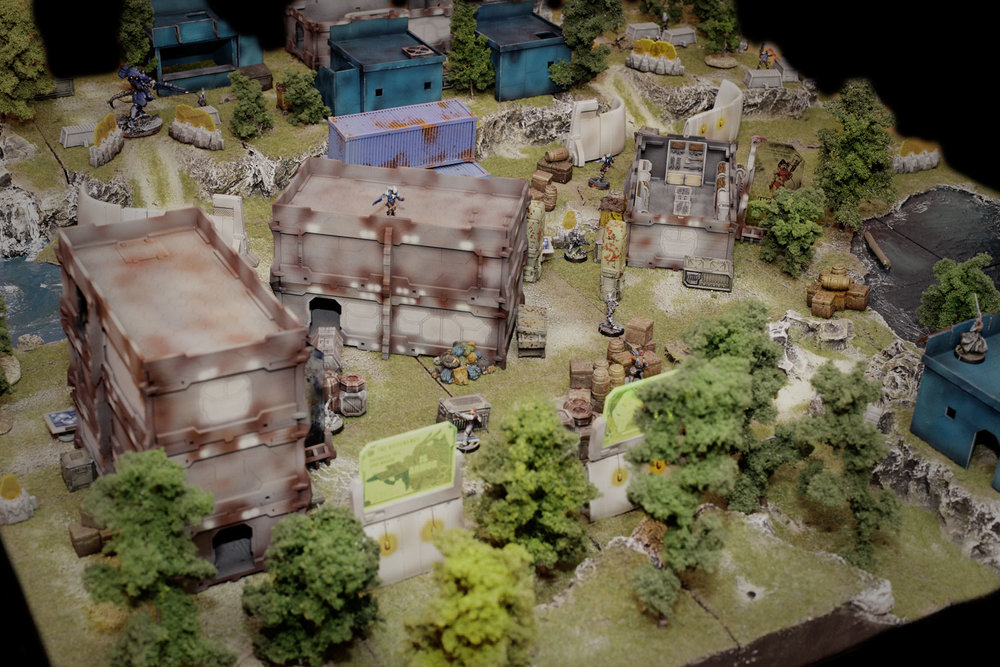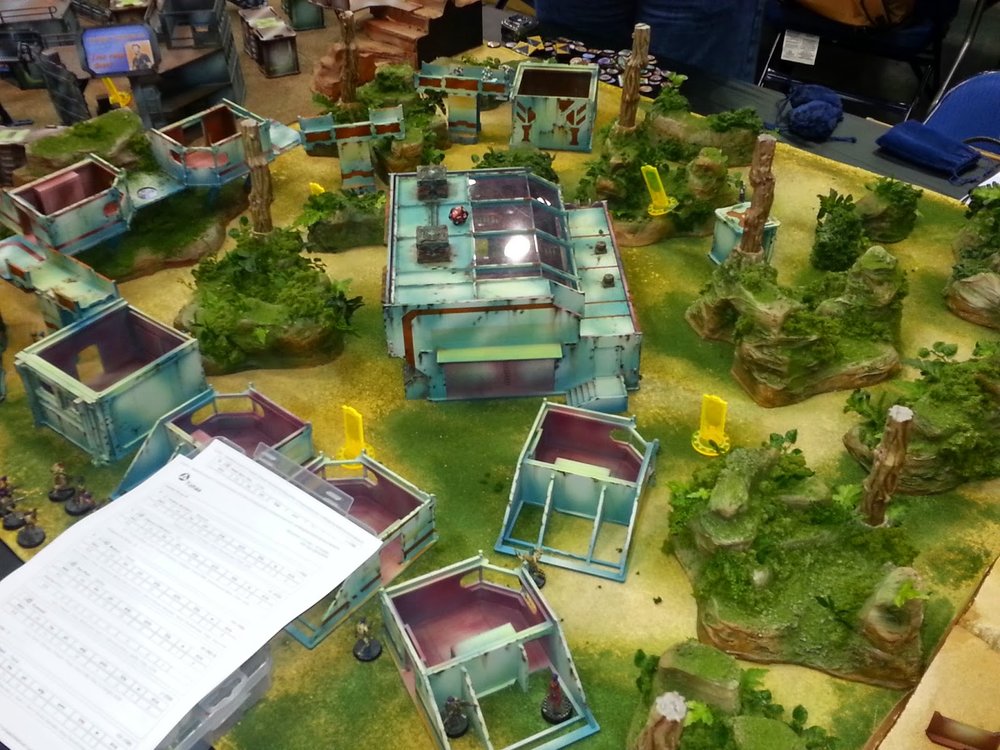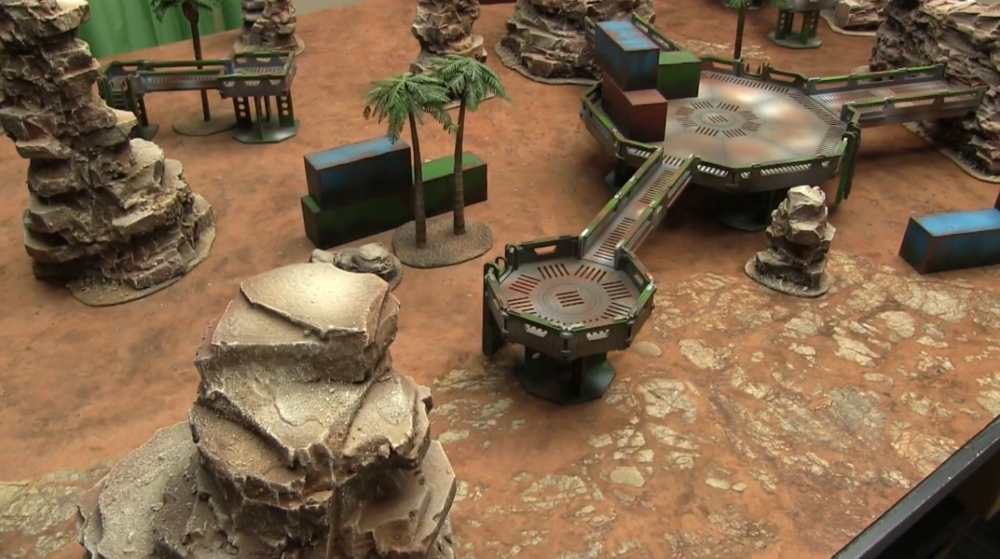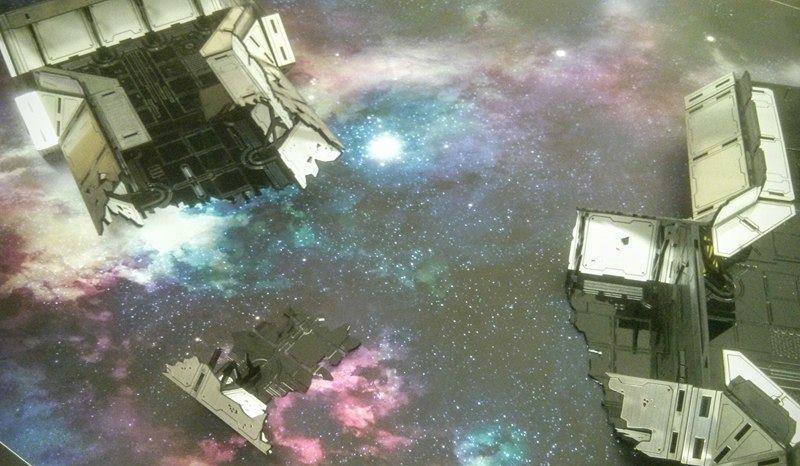Infinity 101: Special Terrain
A gorgeous table using woods and mountains from The Dark Prophet Chronicles.
After playing a few games on my lovely new island table, it has come to my attention that not many people area familiar with how Special Terrain works in Infinity! There is a lot of misinformation, bad habits, and half-correct methods that I’ve seen out there, but if you’re into playing as RAW as possible, then come with me on a journey to the woods!
What is Special Terrain?
Special Terrain is fairly simple, basically any kind of terrain, other than straight forward things like buildings. These rules are meant to encompass anything from woods and rivers, to Zero-G engine rooms and energy cores. The Wiki has a whole ton of suggested types of terrain to pick from to spice up your games.
Here are a few more examples from around the web of infinity tables making use of jungle, mountain, aquatic, desert, and even zero-g terrain, special terrain types:
Despite not being seen on every table, these terrain types are an important part of the game, they provide unique benefits to different units, and interact with a variety of special rules and equipment. Since the rules are not used as often as urban terrain, they are often misunderstood, or outright ignored. But today, lets get into it and figure out how to use it properly so you won’t get intimidated seeing it on tables, and maybe you’ll mix it in to your own terrain.
Lets look at the Special Terrain rule from the wiki:
Special Terrain
Requirements
- Mark Special Terrain areas when you set up the game table, before the game starts.
- These areas must have well-defined, recognizable limits whether they are represented by templates, pieces of scenery, or any other means.
- In game terms, Special Terrain areas have infinite height unless otherwise specified.
- Players must discuss and agree on the specific characteristics of each Special Terrain while setting up the game table.
- Special Terrain areas are categorized according to their MOV Difficulty, Saturation, Visibility Conditions and Type of Terrain.
- Each Special Terrain must have one Type of Terrain and at least one other characteristic.
Area of Effect of Special Terrain Zones
The Area of Effect of a Special Terrain zone is the area in where its special effects are applied.
Any trooper in base contact with a Special Terrain zone, or whose base or Silhouette Template is covered at least partially by Special Terrain zone, is equally affected by the Effects of the zone.
So as we can see, it’s just about any kind of terrain, but needs to have recognizable limits. The rules of the terrain are applied to any model inside of, or contact with the terrain, and also applied to any model who is drawing LOF through the terrain. Some people may use areas of felt, or other material to designate a Special Terrain Zone, though you can also simply have a tree on a base, and count just that base as the Special Terrain Zone.
The wiki has a handy chart, with lots of suggestions of terrain types, be sure to check it out!
Special Terrain and Shooting
It’s important to note, that unless you make special arrangements with your opponent, any scenery element can provide a cover bonus. This means a tree on a base, or a pile of rocks, will not only apply the penalties listed in the chart above, but also provide cover, given the normal requirements for cover are met (i.e. blocking 1/3 of the silhouette).
Here are some examples of how some woods (Difficult Terrain, Low Visibility) would affect shooting:
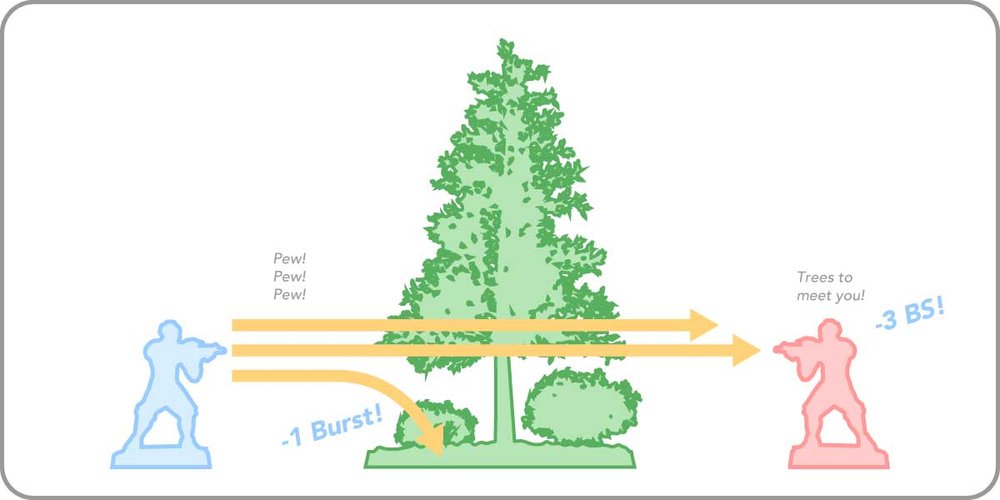
Fig 1a
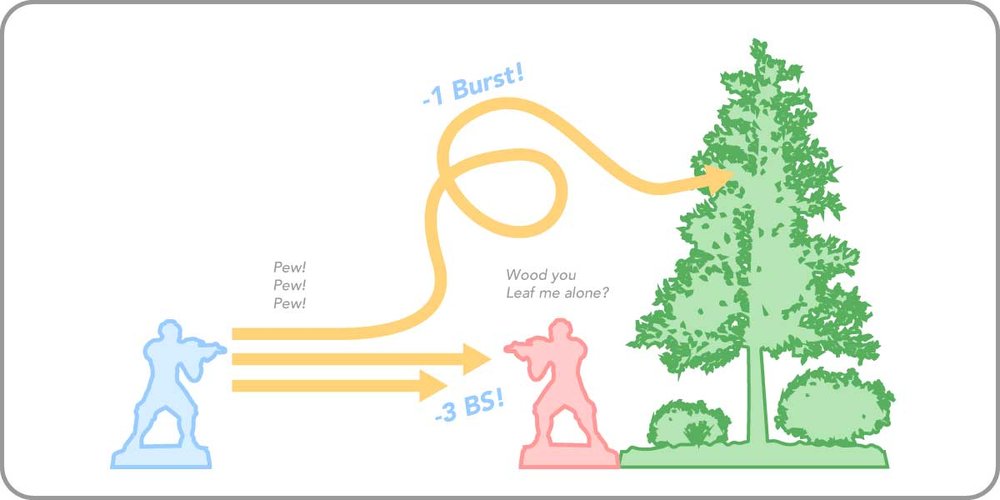
Fig 1b
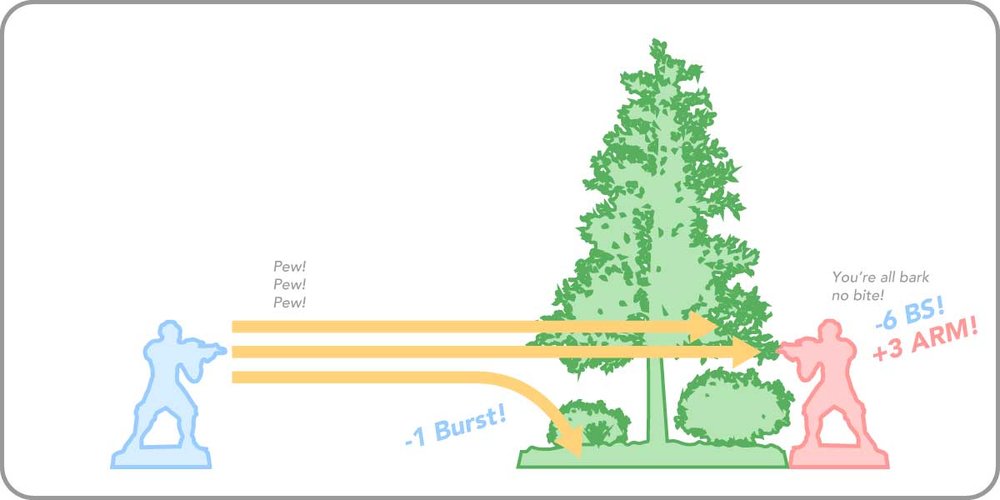
Fig 1c
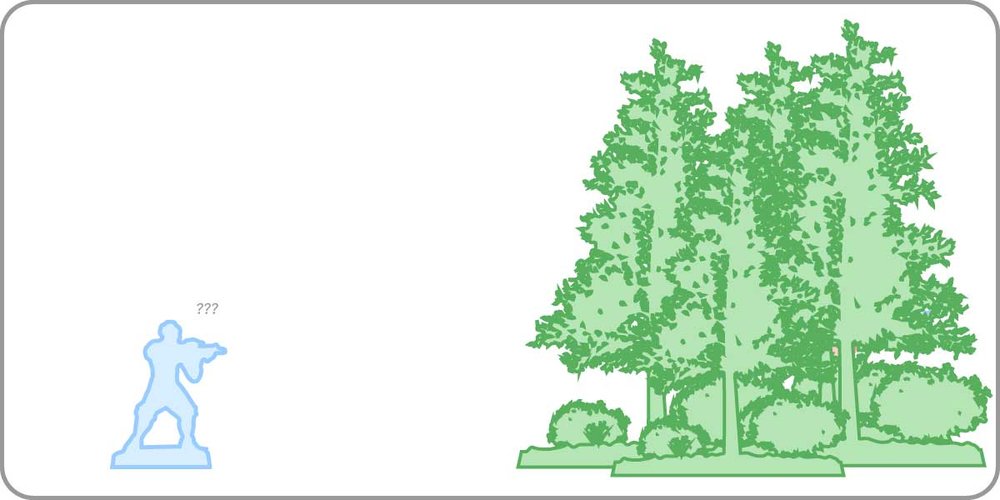
Fig 1d
Fig 1a. Blue is firing at Red through some woods. Since LOF is being drawn through the woods, the shot is affected by the Saturation Zone (-1 Burst) and a Low Visibility Zone (-3 BS).
Fig 1b. Blue is firing at Red, who is in base contact with some woods. Despite LOF not being drawn through them, Red is still protected by the woods, as they are in base contact.
Fig 1c. Blue is firing at Red, who is in base contact with the woods, which are also obscuring at least 1/3 of Red’s silhouette. This means that not only are the special effects of the woods applied, but also Cover.
Fig 1d. Blue cannot see Red to fire at. Despite the woods being a Saturation Zone, the rules for Line of Fire still require that you can see a 3mm square of the enemy model, which is not possible in this case.
Special Terrain and Movement
Now that we know how Special Terrain interacts with shooting, now we need to understand how it works with Movement. First off, there are multiple ways that the difficulty of terrain may affect your movement. Difficult Terrain will restrict you to only moving your secondary movement trait, meaning models that are 4-2, will only move 2″ each order they spend moving. If your model is in Very Difficult Terrain, it goes one step further by not allowing a model to declare a Short Movement Skill for both skills of an order. On top of all of that, models that enter base contact with either Difficult or Very Difficult terrain will end their movement immediately, and not be allowed to continue moving during the same order.
To get around these nasty movement penalties, there are Special Terrain skills, such as Jungle Terrain, Aquatic Terrain, or Multi-Terrain. Each of these skills allows you to ignore these movement penalties in the associated terrain type. Multi-Terrain is by far the most helpful though, as it allows you to pick a terrain type at the beginning of the game and apply the associated skill.
Models with Terrain Skills ignore the Difficult/Very Difficult terrain rules, but are still affected by saturation zones.
Fig 2a
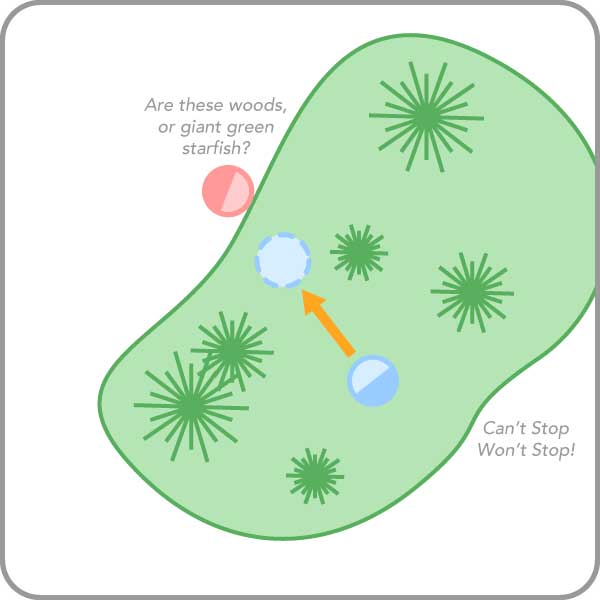
Fig 2b

Fig 2c
Fig 2a. Red and Blue are both spending orders to move into the woods. In this example, Red does not have any terrain associated movement skills, while Blue has Jungle Terrain. Because of this, Red must stop at the edge of the terrain as soon as making contact with it.
Fig 2b. For the second half of the order, Red must perform a skill which isn’t movement. Since Blue has the appropriate terrain skill, they’re welcome to move again for their second skill.
In a future order, if Red were to move, they will be affected by the rules of the terrain, despite not being inside of it, as the terrain effect extends to models in base contact. This means if Red is 4-2, their next move will only let them move 2″, even if moving away from, or just along the edge of the terrain.
Fig 2c. After a few orders, Red is finally to the other side of the woods. Using their secondary movement value, they are able to move completely out of the terrain, into open ground.
You do not need to stop at the edge of the terrain to move out, if you are moving into open ground. If Red was moving from woods into a lake, then they would stop at the edge of the water feature as normal.
Gameplay Summary
Essentially, there actually only a few rules to remember with terrain, other than the specific effects of the terrain piece itself:
- Moving into difficult/very difficult terrain? Stop movement in base contact, no further movement this order.
- Moving out of difficult terrain? Do not stop at edge, but only move second move value for entire order; e.g. MOV 4-2 plays as 2-2 for that order.
- Moving out of very difficult terrain? Do not stop at edge, but only move second move value, may not declare 2 short movement skills; e.g. move-dodge, move-discover, move-move, etc.
- Touching terrain? You are considered in the terrain for all intents and purposes (much like smoke), so suffer movement penalties, as well as saturation zone and visibility zone effects.
- Touching terrain and 1/3 of model is obscured? You are affected by the terrain, and you have cover.
That’s it! From there just apply the effects from the terrain chart and you’re good to go.
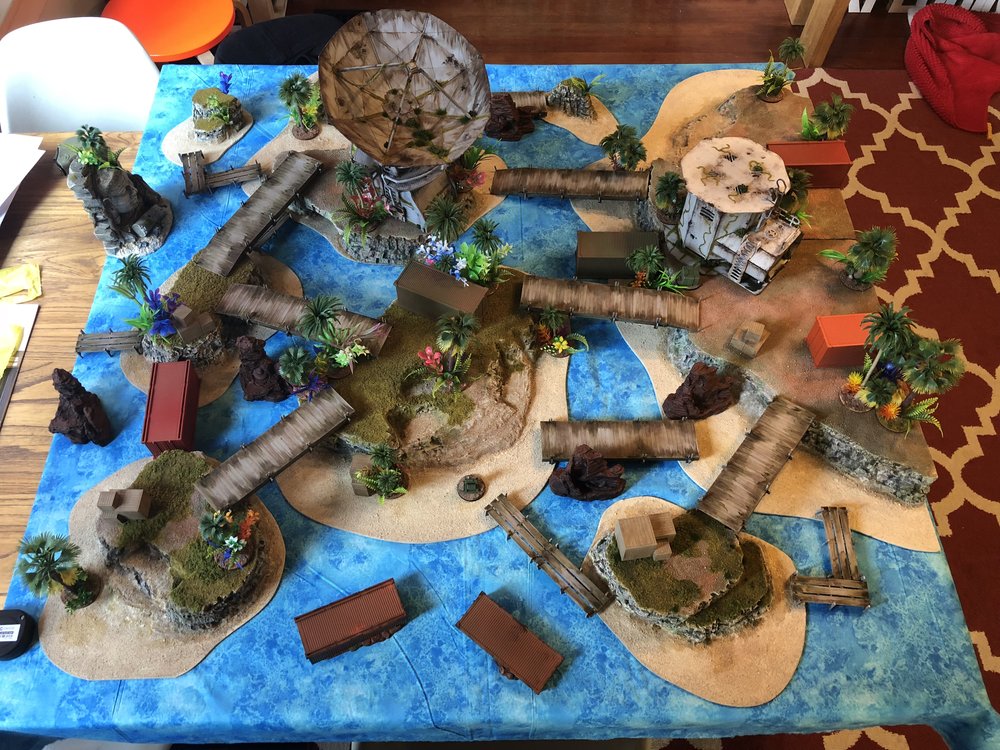
Better be ready to play with some fancy terrain at the Rose City Raid!
On the Table
By using special terrain, you really get to change up the gameplay. After playing on nothing but urban tables, it becomes very easy to predict movement routes and how shooting is going to work, but if you begin to include more woods, desert, and water terrain, you get new problems to solve, and increased value on the units to solve them with.
When you’re playing with Low Visibility zones, like woods, units with MSV1 become a lot more relevant, able to ignore a portion of the penalty to shooting. Similarly, there are many units in the game that pay points for terrain skills, but never get to use them.
Your first couple games on a board with a lot of Difficult or Very Difficult terrain can be rough, since your usual thinking about movement is going to need some adjustment, but the experience is incredibly rewarding. Thinking of new ways to solve problems and accomplish your objectives is not only fun, but will also make you a better player. So don’t be afraid, bust out that terrain!

